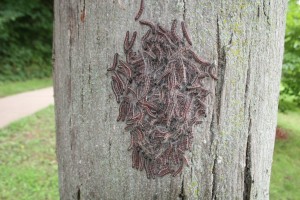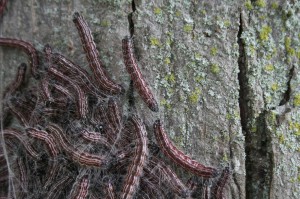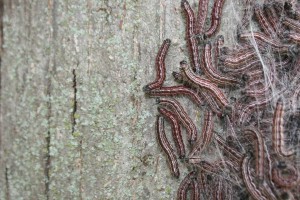(By Dr. Ray Cloyd, Dept. of Entomology)
 We have seen an “explosion” of the walnut caterpillar (Datana integerrima) in several portions of Kansas. Walnut caterpillar feeds on the leaves of walnut, pecan, hickory, and may also feed on birch, oak, and apple. The larvae tend to feed in groups/clusters consuming all leaves on a single branch before moving to another branch to devour leaves. Excessive defoliation may result in sunscald that could weaken trees and increase susceptibility to wood-boring insects. Walnut caterpillar overwinters as a pupa that is located beneath the soil surface under a host tree. Adults are robust moths that emerge from pupae in mid-to-late spring, depending on temperature and host plant growth. The brown forewings possess irregular dark cross lines. Females deposit eggs on leaf undersides with each female capable of laying >300 eggs in a mass. The first instar larvae or caterpillars skeletonize leaves, whereas the second instar larvae feed on the entire leaf with the exception of the mid-vein. The later instar (third and fourth) larvae, which are red in color, feed on the entire leaf including the petiole. Larvae feed for
We have seen an “explosion” of the walnut caterpillar (Datana integerrima) in several portions of Kansas. Walnut caterpillar feeds on the leaves of walnut, pecan, hickory, and may also feed on birch, oak, and apple. The larvae tend to feed in groups/clusters consuming all leaves on a single branch before moving to another branch to devour leaves. Excessive defoliation may result in sunscald that could weaken trees and increase susceptibility to wood-boring insects. Walnut caterpillar overwinters as a pupa that is located beneath the soil surface under a host tree. Adults are robust moths that emerge from pupae in mid-to-late spring, depending on temperature and host plant growth. The brown forewings possess irregular dark cross lines. Females deposit eggs on leaf undersides with each female capable of laying >300 eggs in a mass. The first instar larvae or caterpillars skeletonize leaves, whereas the second instar larvae feed on the entire leaf with the exception of the mid-vein. The later instar (third and fourth) larvae, which are red in color, feed on the entire leaf including the petiole. Larvae feed for approximately one month before reaching maturity. Full-grown larvae are 2.0 inches in length, with yellow stripes on the side, and are gray-black and covered with long, gray to white hairs. When disturbed, larvae will arch their head and the end of the abdomen in order to ward off predators. When it is time to molt, they all gather together on a branch or trunk and molt simultaneously, leaving
approximately one month before reaching maturity. Full-grown larvae are 2.0 inches in length, with yellow stripes on the side, and are gray-black and covered with long, gray to white hairs. When disturbed, larvae will arch their head and the end of the abdomen in order to ward off predators. When it is time to molt, they all gather together on a branch or trunk and molt simultaneously, leaving  patches of fur-like hair. There may be one to two generations per year. The primary effective means of dealing with infestations of walnut caterpillars are to hand-pick caterpillars and place in a container of soapy water, use a forceful water spray to quickly dislodge caterpillars, or apply insecticides with one of the following active ingredients: acephate, spinosad, malathion, cyfluthrin, permethrin, or bifenthrin. Although the eggs and larvae of walnut caterpillars are susceptible to parasitoids, the female parasitoids may not attack enough eggs or larvae to substantially impact the population.
patches of fur-like hair. There may be one to two generations per year. The primary effective means of dealing with infestations of walnut caterpillars are to hand-pick caterpillars and place in a container of soapy water, use a forceful water spray to quickly dislodge caterpillars, or apply insecticides with one of the following active ingredients: acephate, spinosad, malathion, cyfluthrin, permethrin, or bifenthrin. Although the eggs and larvae of walnut caterpillars are susceptible to parasitoids, the female parasitoids may not attack enough eggs or larvae to substantially impact the population.
Author:
Raymond A. Cloyd
Professor and Extension Specialist in Horticultural Entomology/Integrated Pest
Management
Department of Entomology
Kansas State University
123 Waters Hall
Manhattan, KS 66506-4004
Phone: (785) 532-4750
Email: rcloyd@ksu.edu

